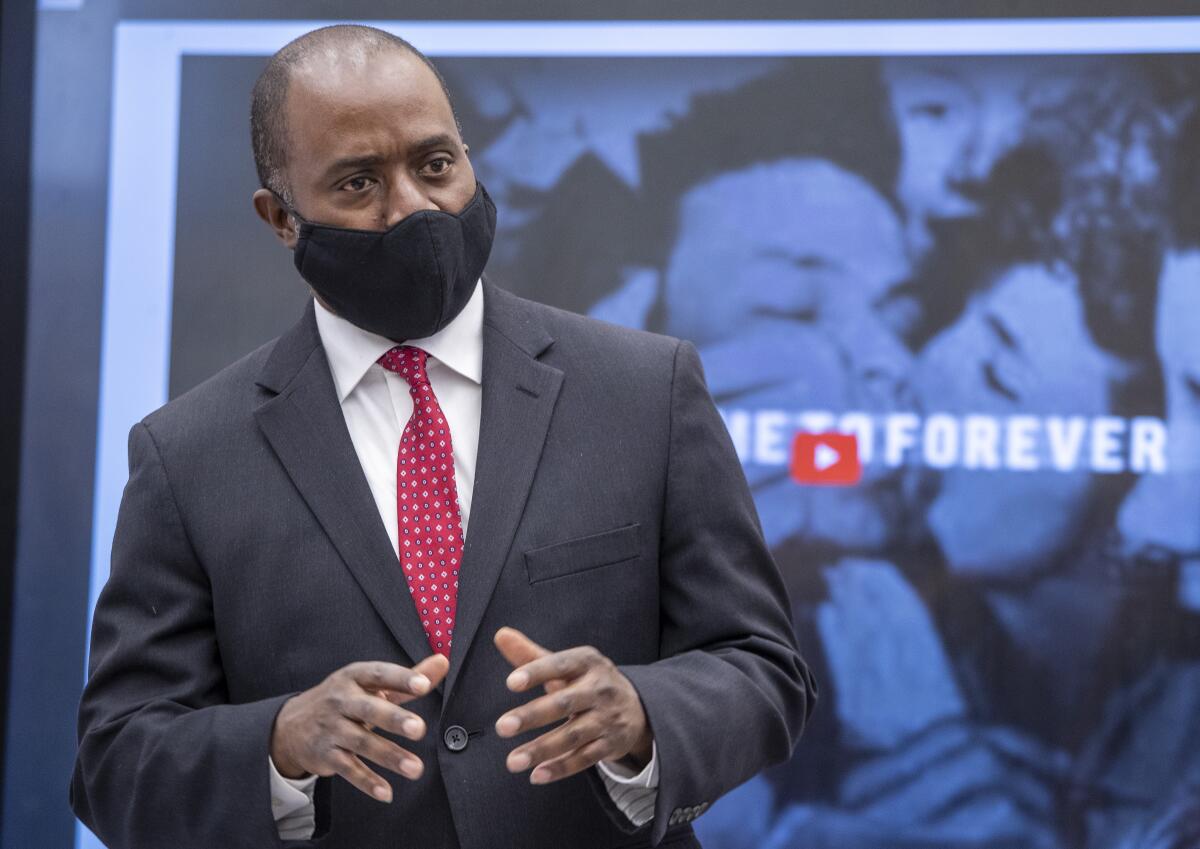State seeks to speed credentials for 10,000 direly needed school mental health counselors

- Share via
Confronted with a shortage of school mental health counselors, the state Department of Education is seeking to bring 10,000 more professionals to campuses at a time when federal public health officials are calling for action to address the nation’s growing youth mental health crisis.
The counselor effort, which requires legislative approval, would aim to entice clinicians into schools through loan forgiveness and deferrals, scholarships to offset education costs and potentially reduce the time it takes for mental health clinicians to get licensed, Supt. of Public Instruction Tony Thurmond said Wednesday during a visit to Washington Preparatory High School in South Los Angeles. Thurmond said he is in talks with legislators and hopes a measure, projected to cost $250 million, can be introduced in coming weeks.
“I can’t think of anything more important right now in terms of dealing with the trauma that students and families have experienced,” Thurmond said. “But the reality is that there is a shortage, there just aren’t enough counselors at many schools and many communities, urban, suburban, rural.”
For years, educators have warned of a shortage of mental health professionals. A 2018 report by researchers at the Healthforce Center at UCSF found that if current trends continued, by 2028, the state will have 41% fewer psychiatrists than needed and 11% fewer psychologists, licensed professional clinical counselors and licensed clinical social workers than needed to meet the state’s healthcare needs.
In December, U.S. Surgeon General Vivek H. Murthy issued a rare public advisory that outlined concerns of a sharp rise in anxiety and depression among young people. The report offered recommendations on what communities — including schools, parents and technology companies — can do to address it.
Murthy’s advisory includes a recommendation to support expanding the workforce for mental health professionals.
“In the school setting, governments should invest in building a pipeline of school counselors, nurses, social workers, and school psychologists,” the advisory states.
Dr. Jonathan Goldfinger, a pediatrician and chief executive of Didi Hirsch Mental Health Services in Los Angeles County, joined Thurmond to speak about the pandemic’s effects on children and how it has led to increased misbehavior in schools.
“We’re seeing the effects of trauma getting literally underneath kids’ skin and manifesting in behaviors in our classrooms, in our homes, in our communities, in our clinics, that we’ve really never seen before,” Goldfinger said. “We have had in the United States a national emerging emergency or pandemic of mental illness in our youth because we have not invested previously in our workforce. We have really treated mental health differently than physical health and acted like it wasn’t as important, when underneath it all, mental health is foundational to physical health.”
Loretta Whitson, executive director of the California Assn. of School Counselors, said the proposal is “a good first step,” but cautioned against sending “less qualified people” in the rush to address the crises.
Aspiring mental health clinicians typically go through more than six years of education and extensive clinical work before working full time, Whitson said. She said a preliminary certification to allow students to assist in school settings could help ease the demand facing schools.
There “could be a system in place where they’re supporting those counselors,” Whitson said. “As long as they’re not supplanting those fully trained.”
Efforts to increase access to a career in mental health by easing financial burdens are welcome, Whitson said, because the problem in expanding the workforce will persist as long as schools see a need.
“There is a mental health crisis in which we have to put all of our energy into our schools to help kids,” Whitson said.
More to Read
Sign up for Essential California
The most important California stories and recommendations in your inbox every morning.
You may occasionally receive promotional content from the Los Angeles Times.











